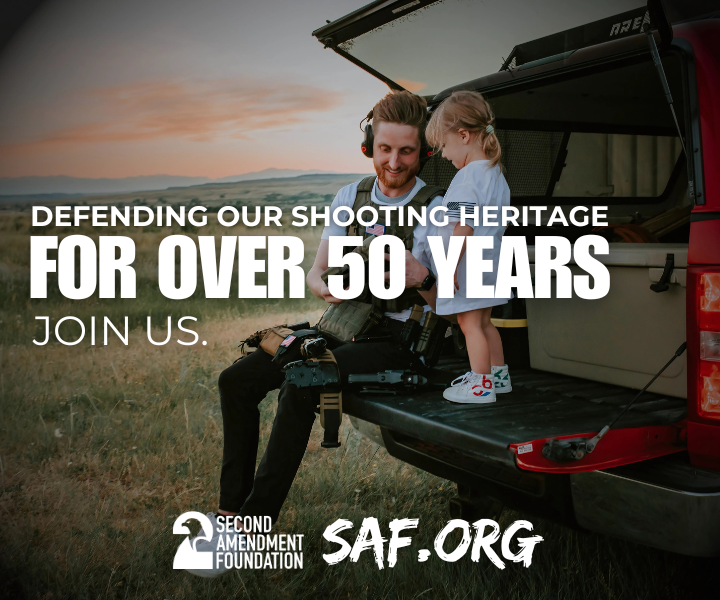
By Jim Dickson | Contributing Writer
The famous 7.62 NATO caliber FN FAL (Fusil Automatique Leger, or Light Automatic Rifle in English) is now only being manufactured in the U.S.
DS Arms has become the sole maker of the gun used by over 90 countries. The story of this rifle began in Russia with the SVT-40 Tokarev rifle. This was a good design ruined by poor workmanship and fragile components, a direct result of Stalin’s purge of anyone perceived of having a mind. Stalin correctly reasoned that anyone who could think for themselves would see through the lies of communism so he set out to purge all seen as competent.
In Belgium, Dieudonne Joseph Saive, chief designer at FN, was impressed by the gas system and the tipping bolt lock of the SVT-40 Tokarev and incorporated them into his design for a semi-auto rifle. WWII interrupted his work and the rifle did not appear on the market until post war when it came out as the FN M1949.
This rifle had only a 10 shot capacity and while sales were initially good it was still an outdated prewar design made obsolete by WWII German innovations such as the MP43 and the FG42. Dieudonne Saive set out to redesign it coming up with what would become the FN FAL.

The design was well thought out and featured superb ergonomics making the rifle fast on target and easy to hit with. The mass center of the rifle was meticulously made the same as the bore line while the stock was made straight and as nearly in line with the bore as possible while still using traditionally mounted sights which allow the soldier to remain lower under protective cover than elevated sights like those on the M16. Everything was done with a view to avoid muzzle climb in full auto though with a 9 pound rifle firing from a closed bolt (which means 50% more recoil than firing from an open bolt) the results were never going to be satisfactory. For this reason most countries issued the FN FAL as a semi-auto only rifle.
Still it was far better than the U.S. M14, which is virtually uncontrollable in full auto fire. Aimed rapid fire is the best way to get hits in combat unless you have a fully controllable full auto designed from the ground up as a machinegun as opposed to a rifle or carbine to which a selector switch has been added.
The gas system could be adjusted by the user from everything to closed off completely for grenade launching to various degrees of open depending on how much gas pressure was needed to operate the action in adverse conditions of extreme cold, sand, dirt, and mud. Any excess gas was bled off to prevent the operation from being too violent and battering the rifle unnecessarily.

The bolt locked with a tilting block, a simple, strong, and easy to manufacture method. The recoil springs were kept safe from sand and mud by being held captive in the stock. They are not removed for cleaning when the gun is field stripped.
The rifle is well sealed against the elements and has been successfully used in all conditions all over the world.
The FN FAL was initially on its way to becoming the standard NATO rifle just as the AK47 was the Warsaw Pact standard but that didn’t happen as the U.S. Army held out for a modified M1 Garand dubbed the M14 saying that both rifles were suitable but the American Army was more familiar with the Garand design. Later when Germany went to FN and asked for a license to produce the rifle in Germany the Belgians treated them so rudely that they went back to Germany and adopted a German design from WWII that had been developed post war in Spain as the CETME. This became the H&K G3 and many countries adopted it ending the FN FAL’s rule as the main rifle of the free world.

Although the U.S. Army did not adopt the FN FAL it’s triangular cross section fore end was copied on the M16 though it was an inferior copy being tapered toward the muzzle instead of parallel sided like the FN FAL resulting in slightly less accurate pointing. The M16’s designers were also impressed with the carrying handle and the M16 had it’s elevated rear sight mounted on a carrying handle.
That does not detract from the FN FAL’s good features though. Disassembly was made as simple as possible. With the magazine out and the bolt closed push in the butt stock’s locking lever at the left rear side of the receiver while pushing the stock down. Pull back on the bolt’s spring rod drawing the bolt and carrier assembly to the back of the gun then slide the receiver cover to the rear taking it off the receiver. The bolt can now be removed from the carrier by lifting the front of the bolt while pushing it forward in the carrier. Continue lifting the front end causing the rear to follow coming gently out of the carrier against the pressure of the firing pin spring. Now hold the rear of the firing pin and push out the cross pin holding it in place so the firing pin spring can force the firing pin out.

The extractor is removed by taking the point of a cartridge and prying out and up to remove the extractor. To clean the gas cylinder insert a cartridge nose and turn the gas cylinder plug and remove it thus allowing the gas piston and spring to be removed. So you can take a bore cleaning rod and clean the gas cylinder as you would the bore.
DSA furnishes a short manual with this gun that is far and away the best that I have seen from an American gun maker in a very long time. For those wanting a much longer and highly detailed military manual on the FN FAL you can get the German army manual on the StG 58 (FAL) that has been translated into English from www.GermanManuals.com. StG 58 is the German name for their FN FAL rifles when they were using them.
DSA makes their DSA FAL on the original tooling used by Steyr-Daimler-Puch to make them under license from FN. Selective fire versions with a cyclic rate of 650-750 rounds per minute are available to police and military customers on demand.
The barrels and upper receiver are precision machined from 4140 steel while the lower receiver is machined from 7075 T6 Aircraft Grade Aluminum. The stock and fore end are made from glass filled nylon. The use of state of the art machinery and heat treating enables DSA to make a higher quality production gun than was possible when the first FN FAL rifles were made in Europe.

The quality was confirmed by the gun sent for review after I picked it up at Reeves Ace Hardware in Clayton, Georgia. It even came with an excellent sling, a necessity for use yet often not included with new guns. I could find no fault with the fit and finish. It came with a modern plastic 20-round magazine. Trigger pull was 11 pounds as measured by a Lyman mechanical trigger pull gage from Brownell’s Gunsmithing Supplies. Acceptable, but I would have preferred a lighter one. Whether for slow fire or aimed rapid fire a light, crisp trigger pull is a great aide to accuracy.
At 9 pounds the rifle would be hard to hold steady on target if it was any lighter. It handles beautifully and the sights seem to align on the target almost by themselves. As a hunting rifle it is just what the doctor ordered for the man who wants one high powered rifle to do everything. It works perfectly on deer and bear and if you need to deal with a pack of wild dogs, coyotes, or wild hogs, you will have great need for that 20-round magazine for if they are running from you it is important not to let any escape.
They sometimes run at you though. I know of two hunters in Georgia alone which have been attacked by coyote packs. I covered the story of Christine Rollins when she was eaten alive by a herd of wild hogs in Texas a few years ago. The sheriff told me that it was the most horrible thing that he had ever seen. Back in the 1960’s when Georgia had a severe problem with wild dog packs it seemed like every game warden had a story about how he experienced an unprovoked attack by a dog pack. Believe me, there are times when a 20-round magazine is a lifesaver.

There is another scenario that is becoming increasingly common in these turbulent times. The hunting rifle may be called upon for self-defense. Your opponents may be many and they may be well armed. A modern main battle rifle is called for in these situations. Sometimes it’s formidable appearance may suffice to make them look for easier pickings elsewhere. At other times only it’s firepower can save you. This is when you need plenty of loaded magazines.
I had 360 rounds of ammo to test fire the rifle with consisting of 200 rounds of Black Hills 175 grain .308 Match BT HP and 160 rounds of Privi Partizan 145-grain BT FMJ. The rifle shot accurately to the sights and was comfortable to shoot with negligible recoil. No one who buys this rifle is going to be disappointed with it. It has served the armies of many nations around the world and it will serve the American sportsman well today.
T


